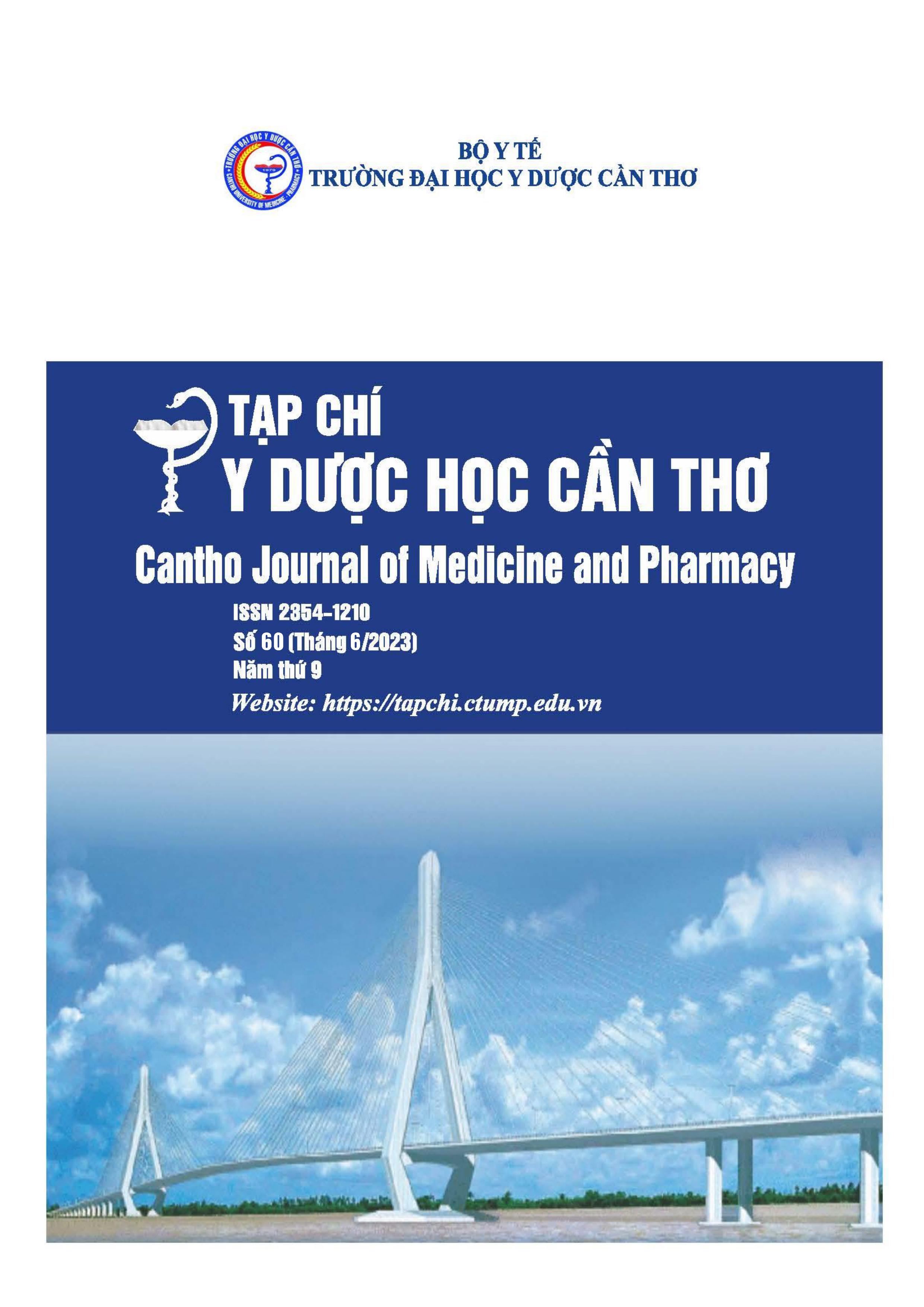NEUROIMAGING OF PEDIATRIC INTRACEREBRAL HEMORRHAGE
Main Article Content
Abstract
In recent years, pediatric stroke has become more popular. According to some research, hemorrhagic stroke accounted for 50% of total stroke in children. Pathogenesis of pediatric intracerebral hemorrhage differs from that in adults. The most common cause of intracerebral hemorrhage is the rupture of congenital vascular malformations which are common in older children while in infants, cerebral hemorrhage is often due to underlying risk factors. Imaging techniques play an useful role in diagnosing cerebral haemorrhage and determining the etiology of hemorrhage. Transfontanellar ultrasound is the best choice in infants when their fontanelle is not closed, suspected of intracerebral hemorrhage in the presence of underlying risk factors such as low birth weight, premature birth, or obstetric trauma. Computed tomography or magnetic resonance imaging diagnose cerebral haemorrhage and find specific causes originating from congenital vascular abnormalities such as rupture of arteriovenous malformations or cavernous venous malformations with characteristic imaging, helping to diagnose and treat promptly.
Article Details
Keywords
Cerebral hemorrhage, pediatrics, transfontanellar ultrasound, computed tomography, magnetic resonance imaging, arteriovenous malformation, cavernous venous malformations
References
2. Sporns P. B et al. Neuroimaging of pediatric intracerebral hemorrhage. Journal of clinical medicine. 2020. 9(5), p. 1518, http://doi:10.3390/jcm9051518
3. Beslow L. A., Ichord R. N. et al. Frequency of hematoma expansion after spontaneous intracerebral hemorrhage in children. JAMA neurology. 2014 .71(2), pp. 165-171. doi:10.1001/jamaneurol.2013.4672
4. Beslow L.A., Licht D. J. et al. Predictors of outcome in childhood intracerebral hemorrhage: a prospective consecutive cohort study. Stroke. 2010. 41(2), pp. 313-318. DOI: 10.1161/STROKEAHA.109.568071
5. Liu J., Wang D. et al. Etiology, clinical characteristics and prognosis of spontaneous intracerebral hemorrhage in children: a prospective cohort study in China. Journal of the
Neurological Sciences. 2015. 358(1-2), pp. 367-370. http://dx.doi.org/10.1016/j.jns.2015.09.366
6. Meyer-Heim A. D. and Boltshauser E. Spontaneous intracranial haemorrhage in children:
aetiology, presentation and outcome. Brain and Development. 2003.25(6), pp. 416-421. doi:10.1016/S0387-7604(03)00029-9
7. Ferriero D.M., Fullerton H. J. et al. Management of stroke in neonates and children: a scientific statement from the American Heart Association/American Stroke Association. Stroke. 2019.50(3), pp. e51-e96. DOI: 10.1161/STR.0000000000000183.
8. Al-Jarallah A., AI-Rifai M. T. et al. Nontraumatic brain hemorrhage in children: etiology and presentation. Journal of child neurology. 2000.15(5), pp. 284-289.
9. Jordan L. C., Kleinman J.T., Hillis, Argye E. Intracerebral hemorrhage volume predicts poor neurologic outcome in children. Stroke. 2009.40(5), pp. 1666-1671. DOI: 10.1161/STROKEAHA.108.541383
10. Lo W. D., Lee J. et al. Intracranial hemorrhage in children: an evolving spectrum. Archives of neurology. 2008.65(12), pp. 1629-1633.
11. Guédon A., Blauwblomme T. et al. Predictors of outcome in patients with pediatric intracerebral hemorrhage: development and validation of a modified score. Radiology. 2018.286(2), pp. 651658. https://doi.org/10.1148/radiol.2017170152
12. Sirvente J., Enjolras O. et al. Frequency and phenotypes of cutaneous vascular malformations in a consecutive series of 417 patients with familial cerebral cavernous malformations. Journal of the European Academy of Dermatology and Venereology: JEADV. 2009.23(9), pp. 10661072. DOI: 10.1111/j.1468-3083.2009.03263.x
13. Kim Seung‐Ki, Cho B.K. et al. Pediatric moyamoya disease: an analysis of 410 consecutive cases. Annals of neurology. 2010.68(1), pp. 92-101. DOI: 10.1002/ana.21981
14. Kossorotoff M., Brousse V. et al. Cerebral haemorrhagic risk in children with sickle‐cell disease. Developmental Medicine & Child Neurology. 2015.57(2), pp. 187-193. DOI: 10.1111/dmcn.12571
15. Luciani A., Rahmouni A., Phạm Ngọc Hoa, Võ Tấn Đức, Thu-Ha Dao, Hà Thị Thanh Tuyền, Nguyễn Anh Tuấn, dịch. Cộng hưởng từ thực hành. NXB Đại học Quốc Gia TP Hồ Chí Minh. 2022. 438. Tập 2-Thần kinh và cơ xương khớp. Tr. 88-91.
16. Zanon E. and Pasca S. Intracranial haemorrhage in children and adults with haemophilia A and B: a literature review of the last 20 years. Blood Transfusion. 2019.17(5), p. 378. DOI 10.2450/2019.0253-18
17. Medley T.L., Miteff C. et al. Australian clinical consensus guideline: the diagnosis and acute management of childhood stroke. International Journal of Stroke. 2019.14(1), pp. 94-106. DOI: 10.1177/1747493018799958
18. Pearce M. S. Salotti J. A., et al. Radiation exposure from CT scans in childhood and subsequent risk of leukaemia and brain tumours: a retrospective cohort study.The Lancet. 2012.380(9840), pp. 499-505. DOI:10.1016/S0140-6736(12)60815-0
19. Papile Lu-Ann, Burstein J. et al. Incidence and evolution of subependymal and intraventricular hemorrhage: a study of infants with birth weights less than 1,500 gm.The Journal of pediatrics. 1978.92(4), pp. 529-534.
20. Rowlan.H. Han, McKinnon A. et al. Predictors of mortality for preterm infants with intraventricular hemorrhage: a population-based study.Child's nervous system. 2018.34, pp. 2203-2213. https://doi.org/10.1007/s00381-018-3897-4
21. Gaillard F., Yap J., Kearns C. et al.Germinal matrix hemorrhage.2023. https://radiopaedia.org/articles/8233.
22. Domingues R., Rossi C., Cordonnier, Charlotte. Diagnostic evaluation for nontraumatic intracerebral hemorrhage.Neurologic clinics. 2015.33(2), pp. 315-328. http://dx.doi.org/10.1016/j.ncl.2014.12.001
23. Ding D., Starke R. M. et al. International multicenter cohort study of pediatric brain arteriovenous malformations. Part 1: predictors of hemorrhagic presentation. Journal of Neurosurgery: Pediatrics. 2016.19(2), pp. 127-135. DOI: 10.3171/2016.9.PEDS16283
24. Fullerton H.J., Achrol A. S. et al. Long-term hemorrhage risk in children versus adults with brain arteriovenous malformations.Stroke. 2005.36(10), pp. 2099-2104. DOI: 10.1161/01.STR.0000181746.77149.2b
25. Lawton M.T., Rutledge W. C. et al. Brain arteriovenous malformations.Nature reviews disease primers. 2015.1(1), pp. 1-20. doi:10.1038/nrdp.2015.8
26. Trần Chí Cường. Chẩn đoán và điều trị bệnh mạch máu thần kinh-đột quỵ. Nhà xuất bản Y Học TP. Hồ Chí Minh. 2016. 354.
27. Anne G. Osborn, Gary L. Hedlund, Karen L. Salzman. Osborn's Brain: Imaging, Pathology, and Anatomy. Elsevier. 2018.1373
28. Bradac, Gianni Boris .Vascular Malformations of the Central Nervous System. Applied cerebral angiography, normal anatomy and vascular pathology. 2017. pp. 207-245. DOI 10.1007/9783-319-57228-4_12
29. Baumgartner J. E., Ater J.L.et al. Pathologically proven cavernous angiomas of the brain following radiation therapy for pediatric brain tumors. Pediatric neurosurgery. 2003.39(4), pp. 201-207. DOI: 10.1159/000072472
30. Nguyễn Thanh Thảo. Hình ảnh học các bệnh lý sọ não thường gặp. NXB Đại học Huế. 2021. 315. tr125-138.
31. Korogi Yukunori et al. Intracranial aneurysms: detection with three-dimensional CT angiograp hy with volume rendering—comparison with conventional angiographic and surgical findings. Radiology. 1999.211(2), pp. 497-506.


